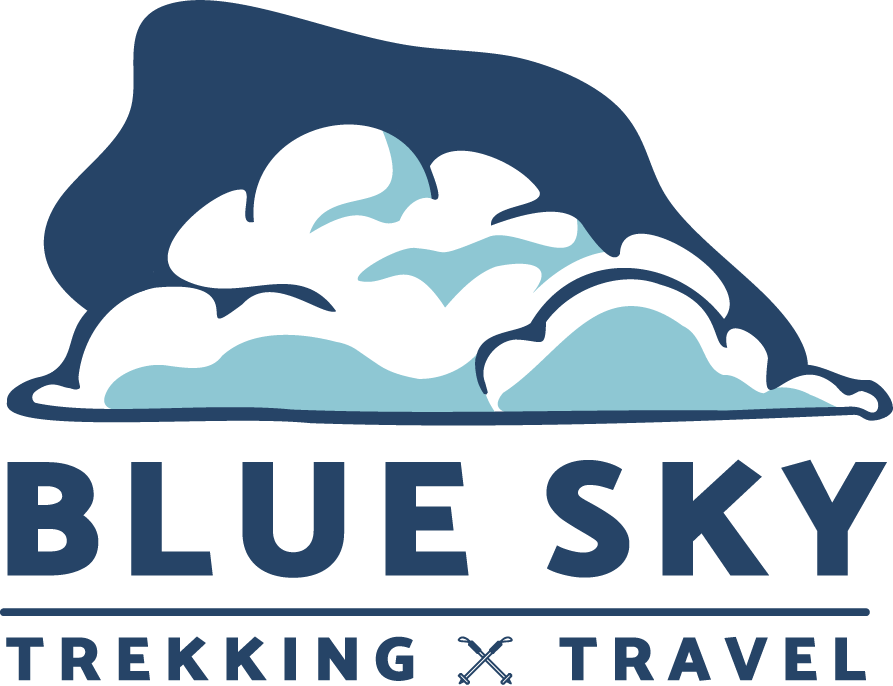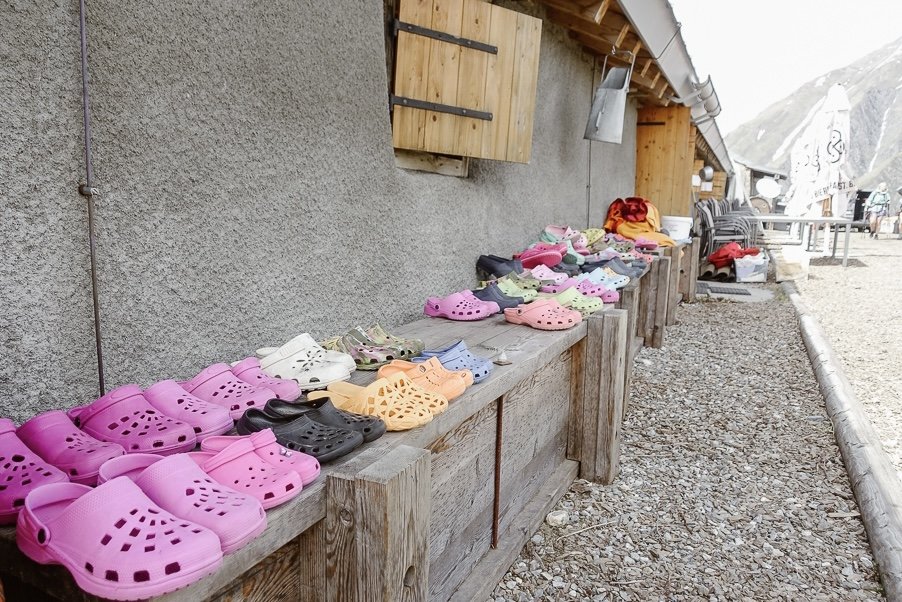The Ultimate European-Trekking Gear List
At Blue Sky Trekking and Travel we absolutely love trekking. You get to have all the fun and adventure of backpacking with the added comforts of sleeping in a warm cozy bed, carrying a lightweight backpack, and getting to enjoy incredible local cuisine for breakfast, lunch, and dinner. At the end of a long day, you get to stay at amazing local inns or mountain refuges where you can meet new people, eat incredible food, and relax in a comfortable bed. When packing for an adventure like this you want to make sure that you have everything you need without adding too much weight to your backpack.
Throughout our many seasons of guiding treks in the mountains, we have crafted a list of gear that we think has struck the perfect balance of comfort and weight. Whether your trip is 3 days or 3 months this list will ensure that you won’t overpack or leave anything important behind.
Backpack:
1 (30-45) liter backpack
1 pack cover or trashbag - for keeping your gear dry
Your pack is certainly one of the most important pieces of gear for a trekking trip, so you want to make sure that you test it out before you buy it. The best way to do this is to try it on in the store and add weight to your pack to make sure that it fits correctly and the weight is evenly distributed between your hips and back.
As for the size of the pack, you’re only going to need between 30 - 45 Liters for a trekking backpack. Personally, I like to go with a ~ 45L pack because it is more versatile. If you wanted you could also use this pack for short backpacking trips and doubles as a great carry-on for weekend trips. The one negative about getting a larger pack is that if you have extra space you are more likely to fill it with STUFF, adding more weight to your back, which you don't want. We offer luggage transfers on most of our Guided Trekking Trips, so for these trips opting for a smaller bag is probably best because you’ll be carrying a lot less throughout the day.
Recommended Packs:
Osprey Kestrel Mens 38L or 48L - comfortable and durable packs with two size options
Osprey Kyte Womens 36L or 46L - this is a woman-specific fit back very similar to the Kestrel
Hyperlite 2400 Southwest - if money’s not an issue, this is our all-time favorite pack.
Shoes:
1 pair of hiking shoes
1 pair of camp shoes or sandals
Along with your backpack choosing which shoes to hike in is critically important. Like a lot of the hiking community, we have ditched those heavy clunky hiking boots several years ago and replaced them with lightweight hiking shoes or trail running shoes. They are much more comfortable, you get fewer blisters, and they are more lightweight so you can be more nimble on your feet. Unless you are carrying super heavy gear or you're doing technical mountaineering you probably don't need big leather or Goretex boots for hiking. We recommend either a trail running shoe or a lightweight hiking shoe depending on the difficulty of the terrain.
Recommended Hiking Shoes:
Altra Lonepeak - This trail runner is also one of the most popular hiking shoes, and for good reason.
It’s great for folks with wider feet and it is incredibly comfortable ( it also comes in a lightweight boot version if you're looking for a bit more stability)
Brooks Cascadia - A comfortable classic trail runner that is great for long distances.
Merril Moad Ventilator - A classic and comfortable hiking shoe that provides stability and traction.
Saloman X Pro 3 - A true lightweight hiking shoe that provides excellent traction and lots of support.
Salewa Mountain Trainer Lite Mid - This shoe is for people wanting the support of a traditional boot but in a comfortable lightweight package. This shoe can tackle technical alpine terrian with ease.
At the end of a long day on the trail, there's nothing better than popping off your trails shoes and slipping your feet into a pair of camp shoes or sandals
Recommended Camp Shoes:
Crocs - Incredibly comfortable, lightweight, and fashionable ;)
Flip flops - a cheap and easy classic
Bedrock sandals - a minimal and durable sandal that will last for years.
Clothing:
When it comes to packing clothing, this is where it becomes easy to bring too much. But, if you follow this list of essentials, you’ll make sure you have everything you need without excess. Also, keep in mind that you will be able to do sink laundry at most lodges for your socks and underwear. (For those of you who have never done sink laundry, it’s wonderfully simple and takes no time at all).
The way we like to think about packing clothes is to visualize the layers you need starting at your feet and working your way up to your head.
Bottom Layers
Socks - (2-3 pairs) - We recommend merino wool because it's lightweight, moisture-wicking, and very comfortable. Saving one clean pair of socks to change into at the end of the day can feel like a great luxury. We love Smartwool Socks
Athletic Underwear - (2-10 pairs) - We’re not here to tell you how many pairs of underwear you should bring. You do you, we won’t judge.
Shorts - (1-2 pairs) - for days on the trail we like hiking in shorts on warmer summer days. Athletic shorts with pockets are our favorites
Hiking Pants - (1 pair) - These can either be worn on the trail for sun protection or at night when the temperatures drop and you want to go check out the stars. Our favorites are Kuhl Pants
Top Layers
T-shirt - (2) - these should be ideally synthetic or merino wool. One can be for hiking and the other you can change into at the end of the day.
Sun Hoody (1 optional) - this has recently become one of our favorite pieces of gear. It’s a long sleeve lightweight hiking shirt with the added benefit of a sun-protecting hood. Our favorite: Black Diamond Alpenglow Hoody or Patagonia Tropic Comfort II Hoody.
Lightweight Fleece (1) - this layer is great at keeping you warm in the evenings or you can also wear it hiking on cooler days in the mountains. Our favorite is the Patagonia R1 fleece, it’s incredibly warm and breathable for its weight.
Puffy Jacket (1) - Depending on where you are going and what time of year you might need a puffy jacket. For those warmer summer months, we recommend the Patagonia Nano Puff Insulated Hoodie. If you are going somewhere a bit colder or are going in the fall, a jacket like the Patagonia Down Sweater Hoodie might be a warmer choice.
Rain gear - A rain jacket is a must-have on any hiking trip, but especially in the mountains. We recommend the Patagonia Torrentshell 3L Jacket because it's affordable and does its job. As for rain pants, in our opinion, unless you are going somewhere where you know you’re going to get a lot of precipitation they are not necessary.
Hat (1) - a baseball hat works great to keep the sun off your face.
Buff (1) - A buff scarf is such a versatile piece of gear. It can be used to shield your neck from the sun, a warm hat if temperatures drop, or as a handkerchief.
Sunglasses (1) - a good pair of sunglass is a must for hiking in the mountains, we recommend also bringing a case to put your sunglasses in when you're not using them so they don't scratch or break
Stuff sack (optional) - to put all your extra clothes. This can help with organization in your pack
Hiking Gear:
Water Bottle (1-2) - it's always good to have at least 2 liters of water carrying capacity. Either 2 1L bottles or a 2L hydration bladder.
Water Treatment (1) - having a way to safely drink from streams on your hike is a must. We recommend the Katadyn BeFree because it's incredibly easy to use, affordable at only $25, and super lightweight at 2oz.
Trekking poles (1) - These can be incredibly helpful in mountainous terrain where you spend most of your time either going up or downhill. We recommend Cascade Mountain Trekking Poles as an affordable option because they are well made, adjustable, and reliable.
Pack towel (1) - Great if you want to swim in an alpine lake or stream during the day or if you are staying at mountain refuges without access to towels.
Travel Sheet (1) - A must-have at refuges and hostels. We recommend silk because it’s comfy and you guessed it lightweight.
Headlamp (1) - it's always nice to carry a headlamp especially if you are in a shared bunkroom for the night and you want to read.
Micro Spikes (optional) - depending on the time of year and elevation where you’re hiking you might need a pair of micro-spikes if there is some snow and ice on the trail. If you are planning on going to the Alps before in early to mid-June it might be a good idea.
Maps -even if you carry your map on your phone its always good to have a physical map as a backup if your phone dies
Personal Gear:
Toiletries: a bag like the Sea to Summit Travelling Light Hanging Toiletry Bag - to keep all your toiletries in is a great idea. A few necessities you don't want to forget in your toiletry bag are:
Soap - 1 small bottle of soap like Dr. Bronners for sink laundry
Earplugs - if you are staying in a shared bunkroom it’s nice to have
Chapstick - with SPF
Sunscreen - a small stick works well for the face and back of the hands
Small first aid kit - You don't want to go out into the mountains without a first aid kit and some knowledge on how to use it. We love Adventure Medical Kits
Phone - great to have for GPS and downloaded maps, a camera - Don't forget a Charger and an Adaptor of the country you are visiting.
ID or Passport - in case of emergency it's nice to have
Money (Cash and Credit Card) - It's always good to have money on you and in some small towns or huts they only accept cash.
Camera (optional) - We love taking pictures on the trail so we always carry a camera, extra batteries, and a charger. We use a Fujifilm XT-3 which is a fantastic interchangeable lens camera for both photo and video.
Book (optional) - having a good book is always a great way to end the day in our opinion. We recommend, Beneath a Scarlet Sky.
Journal (optional) - Sometimes it's nice to sketch or journal at the end of the day but don't forget a Pen or Pencil
Snacks (optional) - We love snacks and we always carry a couple of extra bars or baggies of trail mix just in case.
Deck of Cards (optional) - because who doesn’t like cards?











